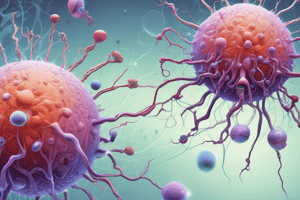Podcast
Questions and Answers
What is the main function of a bacteriophage?
What is the main function of a bacteriophage?
- To provide nutrients to bacterial cells
- To infect and lyse bacterial cells
- To protect bacterial cells from other viruses
- To transfer DNA from one bacterium to another (correct)
What is the name of the bacteriophage that infects Salmonella typhimurium?
What is the name of the bacteriophage that infects Salmonella typhimurium?
- P1
- P3
- P22 (correct)
- P4
What is the result of transduction in a recipient cell?
What is the result of transduction in a recipient cell?
- The recipient cell becomes lytic
- The recipient cell becomes a recombinant bacterium (correct)
- The recipient cell becomes lysogenic
- The recipient cell dies
What is the component of a bacteriophage that surrounds the genetic material?
What is the component of a bacteriophage that surrounds the genetic material?
What is the type of gene that is transferred during transduction?
What is the type of gene that is transferred during transduction?
What is the term for the process by which a bacteriophage infects a bacterial cell?
What is the term for the process by which a bacteriophage infects a bacterial cell?
What is the process by which a bacterium takes up extracellular DNA released by a dead bacterium?
What is the process by which a bacterium takes up extracellular DNA released by a dead bacterium?
Who discovered the process of transformation in 1928?
Who discovered the process of transformation in 1928?
What type of transformation occurs naturally in a wide variety of bacteria?
What type of transformation occurs naturally in a wide variety of bacteria?
What is the term for bacterial cells that are able to take up DNA?
What is the term for bacterial cells that are able to take up DNA?
What occurs after the uptake of DNA into the competent bacterial cell?
What occurs after the uptake of DNA into the competent bacterial cell?
What is the term for a region of mismatch caused by sequence differences between the two alleles?
What is the term for a region of mismatch caused by sequence differences between the two alleles?
What occurs when the transformed DNA is homologous to a region in the bacterial chromosome?
What occurs when the transformed DNA is homologous to a region in the bacterial chromosome?
Why do some bacteria preferentially take up DNA released from dead bacteria of the same or a related species?
Why do some bacteria preferentially take up DNA released from dead bacteria of the same or a related species?
What is the purpose of treating cells with calcium chloride and a high temperature shock in laboratory transformation?
What is the purpose of treating cells with calcium chloride and a high temperature shock in laboratory transformation?
What is the term for the process in which an organism receives genes from another organism without being a direct offspring?
What is the term for the process in which an organism receives genes from another organism without being a direct offspring?
What is a consequence of horizontal gene transfer in bacteria?
What is a consequence of horizontal gene transfer in bacteria?
What is the term for the process by which bacteria acquire genes that confer antibiotic resistance?
What is the term for the process by which bacteria acquire genes that confer antibiotic resistance?
What is the role of competence-stimulating peptide in Streptococcus pneumoniae?
What is the role of competence-stimulating peptide in Streptococcus pneumoniae?
Why is horizontal gene transfer a serious problem worldwide?
Why is horizontal gene transfer a serious problem worldwide?
Flashcards are hidden until you start studying
Study Notes
Bacterial Transduction
- Transduction is the transfer of DNA from one bacterium to another via a bacteriophage, a virus that specifically infects bacterial cells.
- Bacteriophages can transfer bacterial DNA, including P22, which infects Salmonella typhimurium, and P1, which infects Escherichia coli.
- The process of transduction involves a donor cell with a his+ gene, which is packaged into a phage particle and infects a recipient cell, making it a recombinant bacterium that is his+.
Bacterial Transformation
- Transformation is the process by which a bacterium takes up extracellular DNA released by a dead bacterium, discovered by Frederick Griffith in 1928.
- There are two types of transformation: natural transformation, where DNA uptake occurs naturally, and artificial transformation, where DNA uptake occurs with the help of experimental techniques.
- Natural transformation occurs in a wide variety of bacteria, and competent cells carry genes that encode proteins called competence factors, which facilitate DNA uptake and incorporation.
Steps of Transformation
- Extracellular DNA is cut into smaller fragments, and one strand is degraded and transported into a competent bacterial cell.
- Homologous recombination can occur, and any mismatches are repaired by DNA repair enzymes.
- The transformed cell is now lys+.
Recombination
- If the transformed DNA is homologous to a region in the bacterial chromosome, it can be incorporated by homologous recombination.
- If the DNA is not homologous, it may be incorporated at a random site on the chromosome, a process called nonhomologous recombination.
Taking up DNA from the Same Species
- Some bacteria preferentially take up DNA released from dead bacteria of the same or a related species, using mechanisms such as competence-stimulating peptides or DNA uptake signal sequences.
Artificial Transformation
- Laboratory methods are used to get plasmids into cells, including treating with calcium chloride and high temperature shock, or electroporation.
Medical Relevance of Bacterial Genetic Transfer
- Horizontal gene transfer is the process of an organism receiving genes from another organism without being a direct offspring.
- This process can occur within and between species, and includes conjugation, transformation, and transduction.
- Horizontal gene transfer has contributed to the phenomenon of acquired antibiotic resistance, with genes that confer antibiotic resistance being acquired through this process.
Acquired Antibiotic Resistance
- Antibiotic resistance is a serious problem worldwide, with bacteria acquiring genes that break down antibiotics, pump them out of the cell, or block their inhibiting effects.
- Examples of antibiotic-resistant bacteria include methicillin-resistant Staphylococcus aureus (MRSA) strains, which cause serious skin infections.
Studying That Suits You
Use AI to generate personalized quizzes and flashcards to suit your learning preferences.




